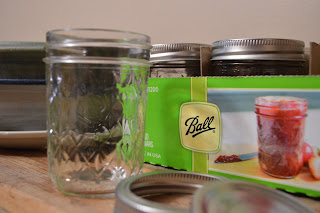Now that the garden has been tucked away for the winter, I have time to begin the inside projects that I have been itching to get accomplished. One of the most pressing needs was to get my bounty of herbs organized and stored.
 |
| Culinary herbs organized! |
I like to incorporate herbs into every part of my day, from my morning tooth powder to my evening cup of Chia tea, and having them easily accessible is key to reaching that goal. With that in mind I focused my attention first on the pantry and kitchen cupboards.
I admit that after a long summer my pantry and cupboards were a mess! Jars of different sizes were interspersed with bags of herbs from Mountain Rose Herbs with little rhyme or reason. This lack of organization made food preparation more difficult than it needed to be.
My solution was to re-purpose a kitchen drawer next to my range into a herbal dispensary. The first step was to find jelly jars with lids and rings. These inexpensive jars are easy to find in stores that stock canning supplies. The wide mouth makes moving herbs in and out easy and convenient.
 |
| These 8 ounces jelly jars are just the right size. |
The depth of my drawer is just shy of 4 inches and the 8 ounce jelly jars are just the right height to fully utilized all the vertical space in the drawer. You can also find 4 ounce jars if your drawer cannot accommodate the 4 inch height of the 8 ounce jar.
 |
| Jelly jars fill all the vertical space. |
 |
| This bamboo spoon is handy for scooping herbs out of the jar. |
My goal was to place all the herbs that are used for culinary purposes in the spice drawer, nourishing herbs used for herbal teas and infusions in the pantry, and herbs used for medicinal needs in the apothecary.
Once the culinary herbs were all tucked away in the jars and labeled, I placed them alphabetically in the drawer and to my delight they fit perfectly. There was just enough room in the back of the drawer for me to place smaller containers in small plastic bins.
 |
| Spices in the front, dog's Frisbee on the top right! |
Next step was the pantry. I placed quart jars of herbs that I use in larger quantities for herbal infusions on the shelves and 8 ounce jelly jars for the space available in the pantry door. I like using glass as it does not leach unwanted chemicals into my herbs, blocks moisture, makes the contents of the jar visible, and can be used over and over again.
 |
| Labeling the jars helps you identify the herb if the lids get mixed up. |
 |
| Such a feeling of security knowing I have all these options for healing. |
This walkway lined with shelves is dark which helps keep my herbs fresh and potent. Moisture and sunlight will deteriorate herbs, so in addition to storing them in a dark location, I also use a vacuum sealer attachment to remove the air and seal the jars. You can check out the process by reading this post.
 |
| Herbal tincture are stored opposite of the dried medicinal herbs. |
Since I discontinued the use of all over-the-counter and pharmaceutical drugs about five years ago, I have really had to "up" my herbal game and as a result have become somewhat of a collector.
If a family member is sick, I want to have a remedy on hand as I may not have time to wait for the delivery of an online purchase or travel 20 miles to the nearest co-op. So from spring to fall I am busy harvesting the leaves, flowers, berries, and roots of both cultivated and wild plants. To learn more about harvesting, drying, and storing herbs, click here.
To accommodate the storage needs of all these herbs along with the dehydrated tomatoes, maple syrup, vinegar and other backyard bounty, we have converted our small crawl space into a storage area. Pre-finished shelves from the local lumber store were set on concrete blocks left over from our root cellar project to line the perimeter of the space with sturdy shelves.
 |
| Extra herbs, dehydrated vegetables, and canned goods fill the crawl space. |
Once you incorporate herbs into your daily routine, you will learn how much of each herb you need to have on hand. For example, I use a lot of nettle for my daily nourishing infusions, so I want to harvest as much as I can during the spring and early summer. After I have placed one quart jar in the pantry the other four will be stored in the crawl space.
To make sure I am using my harvesting time and efforts efficiently, this fall I created an inventory on my google drive to track how much of each harvested plant/vegetable I had in storage at the end of the summer. Next spring I can check the inventory to determine which herbs I need to harvest.
I am always striving to work smarter (not harder) and love new ideas, so please post a comment if you have something fun to share.





